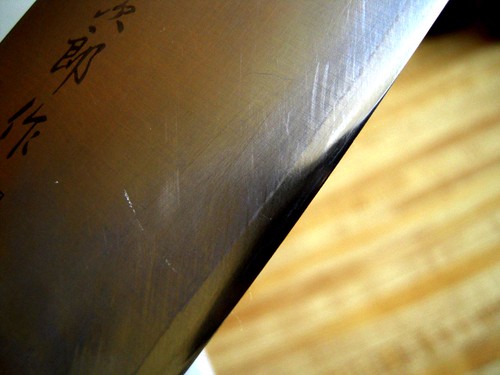
After seeing how well the chefs (at
Konohana, the sousaku-ryori restaurant I worked at last year in Tokyo) and the housewives in Japan take care of their hōchōs (Japanese cutlery), one of the first things I did when I moved back to the U.S. was to get a knife sharpener for my carbon-steel hōchō I purchased in
Kappabashi two years ago. Luckily, a Japanese knife and tool shop called
Hida Tool & Hardware Co., Inc., is a short, less-than-10-minute walk from my Berkeley apartment. The staff showed me a range of water stones that would be ideal for my hōchō and my budget ($50). I ended up purchasing a 1000 grit water stone for $40. If I win the lottery, I hope to invest in a 3000-6000 grit stone (priced at about 3-5 times that of a 1000 grit stone) for a superior, fine finish.
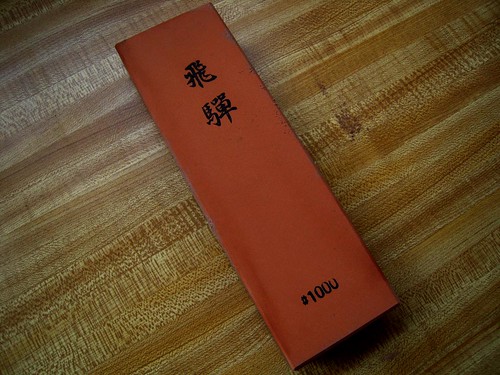
The staff person at Hida Tool took me to the back of the store for a quick demonstration of how to use the water stone for sharpening, which proved very helpful. After sharpening my knife once a week for the past 2 months, I am finally getting the hang of it - using not just my hands and wrists but my whole torso to propel a motion that seems less stressful for both me and my knife. Here's how to sharpen a steel-based knife on a water stone. 1. Soak water stone for
2-3 30 minutes.
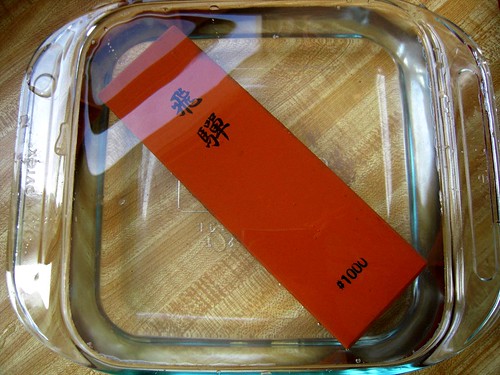
2. Place stone on a wet towel for stabilization. 3. Sprinkle some water on the stone. 4. Sharpen the knife at a 15 degree angle. The Hida Tool knife sharpener said that should be equivalent to stacking two quarters on the non-sharp edge of the blade.

5. With the blade edge towards you,
push the knife away from you at the 15 degree angle. Apply firm but not immense pressure as you push it away from you. Repeat in a rhythmic motion. Once you feel the curled metal of the blade edge, flip the knife over.
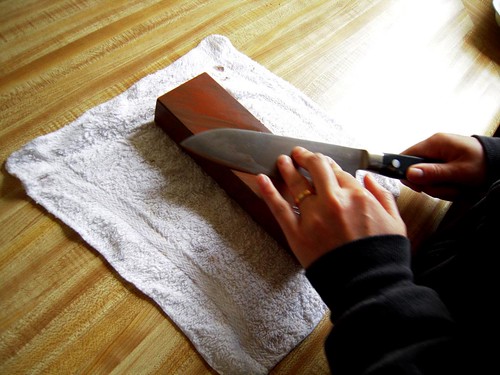
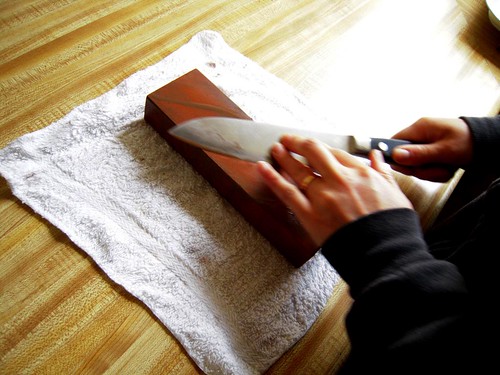
6. With the blade edge away from you,
pull the knife towards you at the 15 degree angle. Again, apply pressure confidently. Repeat in a rhythmic motion.

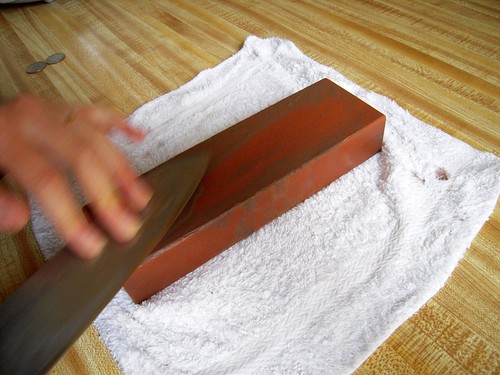
7. After the knife is sharpened, clean the knife and wipe dry. Inspect your beautiful work and test out on a piece of paper (no cardboard) or food.

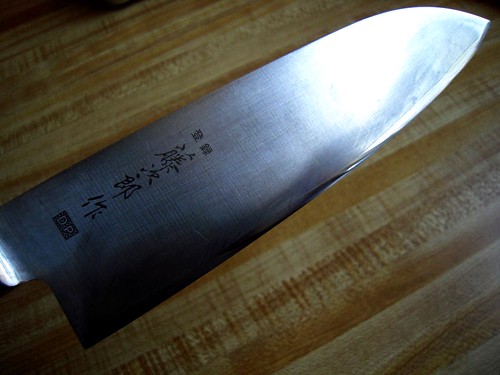
8.
DO NOT clean the water stone after use. The clayish "mud" should be left alone to dry. These fine particles will improve the sharpening performance of your water stone. REVISION: I had the Hida Tools knife master Chika-san review my article and she said to clean the water stone after use. What she did say was to NOT clean it
while you are sharpening the knife. Deep apologies for the misinformation.
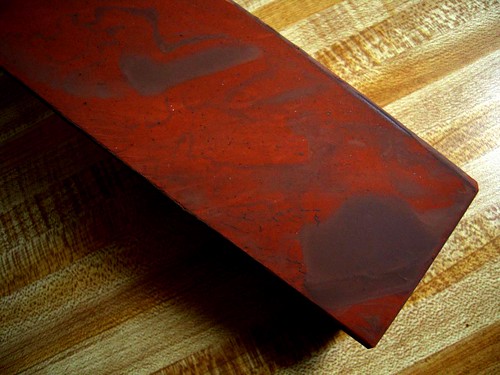
 After seeing how well the chefs (at Konohana, the sousaku-ryori restaurant I worked at last year in Tokyo) and the housewives in Japan take care of their hōchōs (Japanese cutlery), one of the first things I did when I moved back to the U.S. was to get a knife sharpener for my carbon-steel hōchō I purchased in Kappabashi two years ago. Luckily, a Japanese knife and tool shop called Hida Tool & Hardware Co., Inc., is a short, less-than-10-minute walk from my Berkeley apartment. The staff showed me a range of water stones that would be ideal for my hōchō and my budget ($50). I ended up purchasing a 1000 grit water stone for $40. If I win the lottery, I hope to invest in a 3000-6000 grit stone (priced at about 3-5 times that of a 1000 grit stone) for a superior, fine finish.
After seeing how well the chefs (at Konohana, the sousaku-ryori restaurant I worked at last year in Tokyo) and the housewives in Japan take care of their hōchōs (Japanese cutlery), one of the first things I did when I moved back to the U.S. was to get a knife sharpener for my carbon-steel hōchō I purchased in Kappabashi two years ago. Luckily, a Japanese knife and tool shop called Hida Tool & Hardware Co., Inc., is a short, less-than-10-minute walk from my Berkeley apartment. The staff showed me a range of water stones that would be ideal for my hōchō and my budget ($50). I ended up purchasing a 1000 grit water stone for $40. If I win the lottery, I hope to invest in a 3000-6000 grit stone (priced at about 3-5 times that of a 1000 grit stone) for a superior, fine finish.  The staff person at Hida Tool took me to the back of the store for a quick demonstration of how to use the water stone for sharpening, which proved very helpful. After sharpening my knife once a week for the past 2 months, I am finally getting the hang of it - using not just my hands and wrists but my whole torso to propel a motion that seems less stressful for both me and my knife. Here's how to sharpen a steel-based knife on a water stone. 1. Soak water stone for
The staff person at Hida Tool took me to the back of the store for a quick demonstration of how to use the water stone for sharpening, which proved very helpful. After sharpening my knife once a week for the past 2 months, I am finally getting the hang of it - using not just my hands and wrists but my whole torso to propel a motion that seems less stressful for both me and my knife. Here's how to sharpen a steel-based knife on a water stone. 1. Soak water stone for  2. Place stone on a wet towel for stabilization. 3. Sprinkle some water on the stone. 4. Sharpen the knife at a 15 degree angle. The Hida Tool knife sharpener said that should be equivalent to stacking two quarters on the non-sharp edge of the blade.
2. Place stone on a wet towel for stabilization. 3. Sprinkle some water on the stone. 4. Sharpen the knife at a 15 degree angle. The Hida Tool knife sharpener said that should be equivalent to stacking two quarters on the non-sharp edge of the blade.  5. With the blade edge towards you, push the knife away from you at the 15 degree angle. Apply firm but not immense pressure as you push it away from you. Repeat in a rhythmic motion. Once you feel the curled metal of the blade edge, flip the knife over.
5. With the blade edge towards you, push the knife away from you at the 15 degree angle. Apply firm but not immense pressure as you push it away from you. Repeat in a rhythmic motion. Once you feel the curled metal of the blade edge, flip the knife over. 
 6. With the blade edge away from you, pull the knife towards you at the 15 degree angle. Again, apply pressure confidently. Repeat in a rhythmic motion.
6. With the blade edge away from you, pull the knife towards you at the 15 degree angle. Again, apply pressure confidently. Repeat in a rhythmic motion. 
 7. After the knife is sharpened, clean the knife and wipe dry. Inspect your beautiful work and test out on a piece of paper (no cardboard) or food.
7. After the knife is sharpened, clean the knife and wipe dry. Inspect your beautiful work and test out on a piece of paper (no cardboard) or food. 
 8.
8. 
